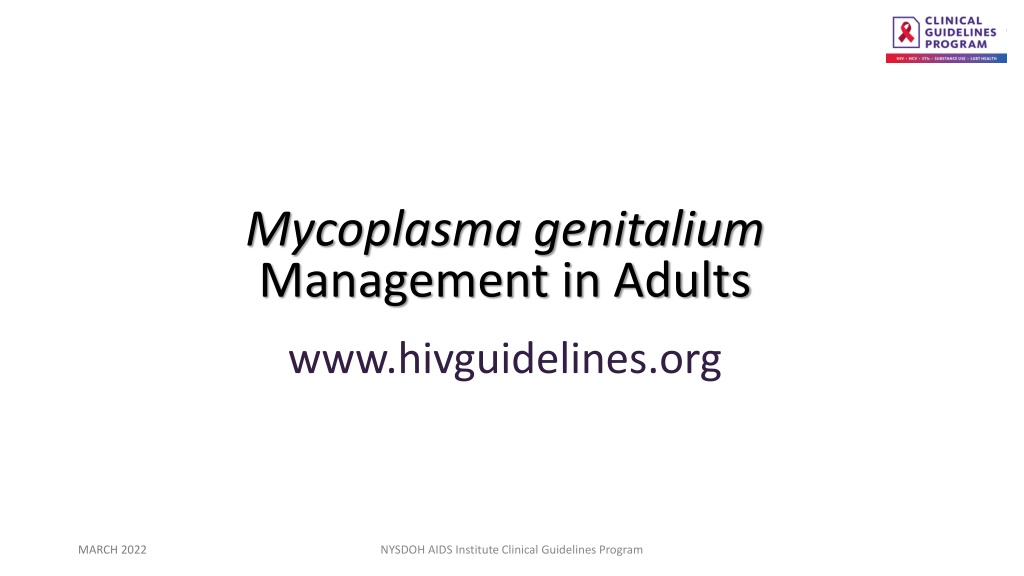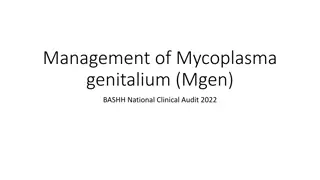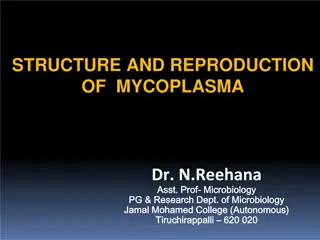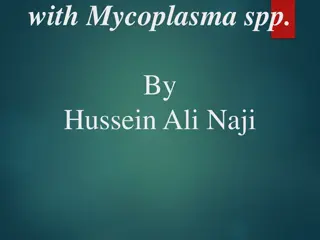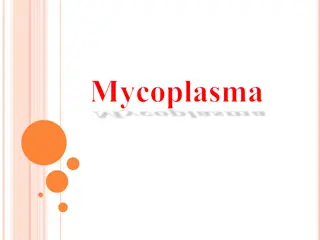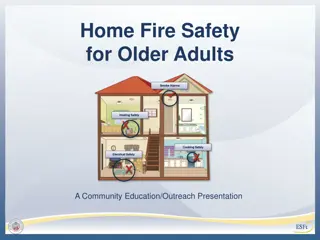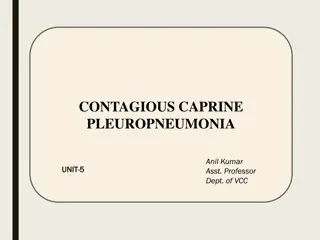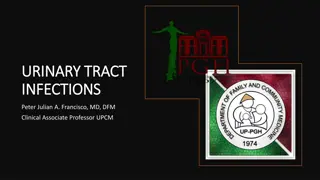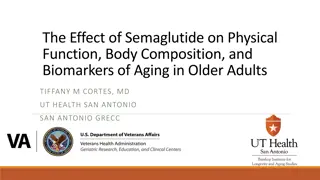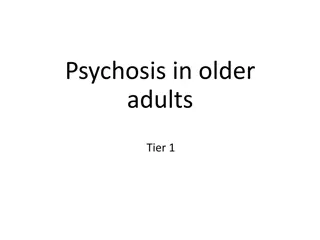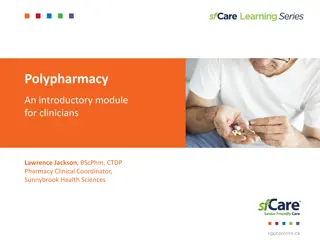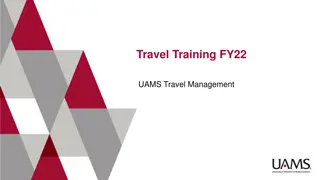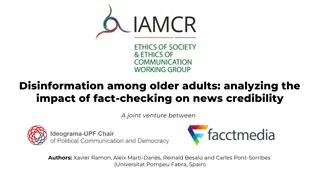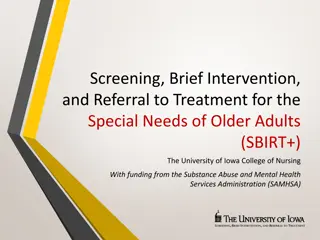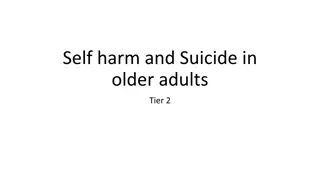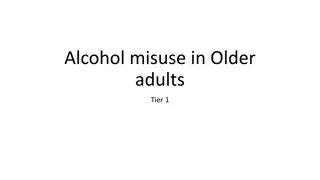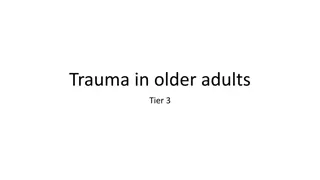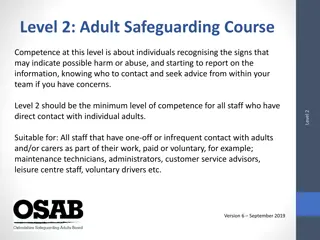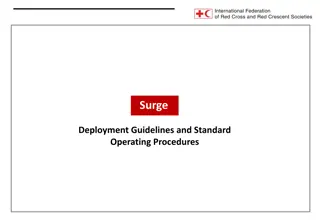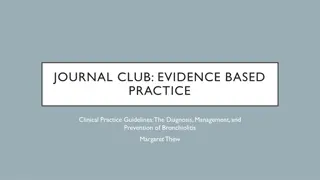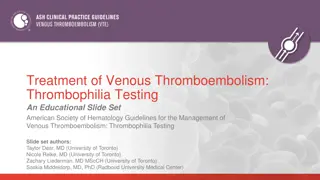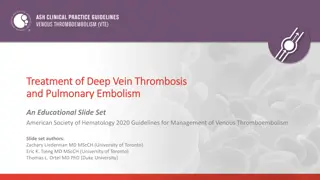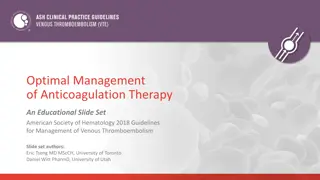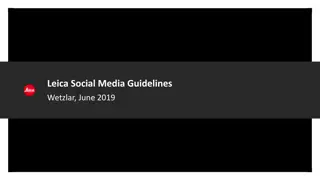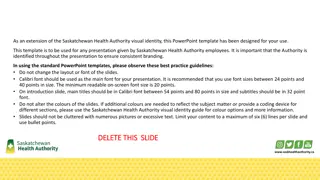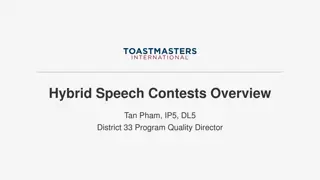Mycoplasma Genitalium Management Guidelines for Adults
This guideline aims to assist clinicians in recognizing common clinical manifestations of M. genitalium infection, providing evidence-based recommendations on screening, diagnostic testing, and treatment. It emphasizes not routine screening for asymptomatic individuals but testing for those with persistent symptoms or as current sex partners of infected individuals. Treatment recommendations are based on antimicrobial regimens for urethritis, cervicitis, and PID caused by M. genitalium.
Download Presentation

Please find below an Image/Link to download the presentation.
The content on the website is provided AS IS for your information and personal use only. It may not be sold, licensed, or shared on other websites without obtaining consent from the author. Download presentation by click this link. If you encounter any issues during the download, it is possible that the publisher has removed the file from their server.
E N D
Presentation Transcript
Mycoplasma genitalium Management in Adults www.hivguidelines.org MARCH 2022 NYSDOH AIDS Institute Clinical Guidelines Program
Purpose of This Guideline Purpose of This Guideline Assist clinicians in recognizing common clinical manifestations of M. genitalium infection. Provide clinicians with evidence-based recommendations on screening, diagnostic testing, and treatment of M. genitalium infection. Ensure that NYS recommendations for M. genitalium screening, diagnosis, and treatment reflect the rapidly evolving evidence regarding the organism, infection, potential complications, and implications of drug resistance. MARCH 2022 NYSDOH AIDS Institute Clinical Guidelines Program www.hivguidelines.org
Prevalence Prevalence Varies depending on the clinical setting and population being tested: General U.S. population: 1% to 4% Worldwide among STI clinic settings: >4% to 40% Most reports suggest that asymptomatic infection is common. MARCH 2022 NYSDOH AIDS Institute Clinical Guidelines Program www.hivguidelines.org
Recommendations: Recommendations: Laboratory Testing and Diagnosis Laboratory Testing and Diagnosis Clinicians should not routinely screen for M. genitalium in asymptomatic individuals. (A3) Clinicians should test for M. genitalium in individuals with persistent or recurrent urethritis or cervicitis. (B2) When testing is indicated, clinicians should use nucleic acid amplification testing (NAAT) to diagnose M. genitalium infection, with resistance testing if available. (A2) MARCH 2022 NYSDOH AIDS Institute Clinical Guidelines Program www.hivguidelines.org
Key Point: Key Point: Laboratory Testing and Diagnosis Laboratory Testing and Diagnosis Asymptomatic M. genitalium infection is common and its implications unclear; therefore, routine screening is not recommended, and diagnostic testing is reserved for individuals who: Have persistent or recurrent urethritis or cervicitis or PID in the absence of gonorrhea or chlamydia and with persistent symptoms despite therapy Are current sex partners of individuals treated for symptomatic M. genitalium infection MARCH 2022 NYSDOH AIDS Institute Clinical Guidelines Program www.hivguidelines.org
Recommendations: Recommendations: Treatment Treatment Clinicians should treat patients with urethritis (A2), cervicitis (A2), and PID (B2) caused by M. genitalium infection as recommended in Recommended Antimicrobial Regimens for M. genitalium Infection Treatment. When M. genitalium testing is unavailable, clinicians should treat patients when there is a high clinical index of suspicion for M. genitalium infection and other STIs have been reasonably excluded from the differential diagnosis. (B3) MARCH 2022 NYSDOH AIDS Institute Clinical Guidelines Program www.hivguidelines.org
Recommended Antimicrobial Regimens for Recommended Antimicrobial Regimens for M. genitalium M. genitalium Infection Treatment Infection Treatment Selected Conditions Oral Regimens Considerations M. genitalium detected by FDA-approved NAAT Pregnant patients: Doxycycline and moxifloxacin are generally not recommended Preferred for PID: 14-day moxifloxacin-containing regimen Resistance testing unavailable or macrolide resistant Doxycycline 100 mg twice daily for 7 days followed by moxifloxacin 400 mg once daily for 7 days Patients with persistent symptoms: If this regimen is used in the absence of macrolide- susceptibility testing, perform test of cure at 21 days after treatment is completed Pregnant patients: Doxycycline is generally not recommended Macrolide susceptible or moxifloxacin unavailable Doxycycline 100 mg twice daily for 7 days followed by azithromycin 1 g on day 1 followed by azithromycin 500 mg once daily for 3 days M. genitalium NAAT unavailable Pregnant patients: Doxycycline and moxifloxacin are generally not recommended Preferred for PID: 14-day moxifloxacin-containing regimen High clinical index of suspicion (other STIs should be reasonably excluded prior to initiating treatment) Doxycycline 100 mg twice daily for 7 days followed by moxifloxacin 400 mg once daily for 7 days Note: A 14-day regimen containing moxifloxacin (400 mg per day) is effective for PID treatment, in addition to an empiric 14-day regimen for PID that contains doxycycline. The evaluation and treatment of PID are not limited to the management discussed here. MARCH 2022 NYSDOH AIDS Institute Clinical Guidelines Program www.hivguidelines.org
Need Help? Need Help? NYSDOH AIDS Institute Clinical Guidelines Program www.hivguidelines.org
Access the Guideline Access the Guideline www.hivguidelines.org > Mycoplasma genitalium Management in Adults Also available: Printable PDF NYSDOH AIDS Institute Clinical Guidelines Program www.hivguidelines.org
